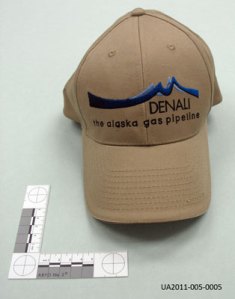When you’re working with a local history collection, you never know the kinds of things that will present themselves. One of the most difficult things to know is what will be important for future generations to understand our current time; what should we be keeping in order to most accurately convey our place in the history of Interior Alaska?
Donor: Joshua Reuther
As a former UAF student and local musician, Joshua Reuther was quite familiar with The Marlin, a local pub close to campus and known for its “close quarters” and eclectic musical performances. While working many years ago at The Doghouse (now Pad Thai Restaurant) he was given a Blue Marlin t-shirt by the owner Gerry Ostrow. As with most pubs, the Marlin had undergone changes in ownership and with that change, a slight variation to the business name. The Blue Marlin name represents the bar at a time prior to ca. 1996 when it was known for having the “best damn pizza in Alaska,” according to this t-shirt. While it may seem odd to have a t-shirt in a museum collection, we actually have 13 such shirts! We find that t-shirts are a straightforward technique for representing pop culture of a local community, with their period-specific graphics and messages. They are ubiquitous, and therefore, a veritable requirement for a history collection.

Flying disk, used during the summer 2011 at the Meade Site, a UAF archaeological field school sponsored by Denali.
Also donated by Reuther, an archaeologist who works for Northern Land Use Research in Fairbanks, are a collection of items used by NLUR while working on surveys for Denali – the Alaska Gas Pipeline project. The company, an LLC of ConocoPhillips and BP, formerly closed their operations on May 17, 2011 citing “a lack of customer support.” This controversial company was conducting the preliminary surveys to move forward on a route to bring natural gas to the Lower-48, while the state of Alaska was working on a separate route through the AGIAprocess. These four artifacts bear the logo of Denali and were distributed to contractors as part of their advertising campaign and will now help serve as symbols of this story of one of the first “boom and busts” of the gas line process.
Donor: Grace Berg Schaible
Grace Schaible has long been a friend to the UA Museum of the North. Grace is known for being Alaska’s first female attorney general (1987-1989) and an avid art collector. A major component of Grace’s collection are representations of polar bears, both in 2D and 3D. In 2011 she donated two very large whale bone carvings of polar bears, carved by Ronald “QAY” Apangalook (Qaygeghutaq) originally of Gambell, St. Lawrence Island, Alaska. In these two lovely pieces, QAY uses baleen for the eyes and nose and in the single bear, walrus ivory for the bear’s claws. Pieces like this are especially welcome in the Ethnology collection because whale bone is a relatively stable medium that can hold up to more lengthy exhibition periods and slightly more variable environmental conditions (compared to more vulnerable materials like dyed skin or grass or sculptural materials like wood or walrus ivory).
Donor: Craig E. Dorman, Ph.D.
One of the last donations of 2011 is an incredible set of seven nesting baskets, made by the donor, Craig E. Dorman. Dr, Dorman is a past director of the Woods Hole Oceanographic Institute, retired rear Admiral and program director for anti-submarine warfare in the Space and Naval Warfare Systems Command. Most recently, Dorman was the Vice President for Research with the University of Alaska.
Dorman produces these baskets, known as Nantucket Lightship Baskets, now that he is retired. He documents them with great detail and the workmanship is outstanding. His innovations include tiny twists in the weavers and staves that are dyed or made from varied materials, as in these baskets. In this set of seven tightly-nested baskets there are a total of 4915 curls! This tiny detail is one of the reasons this group of baskets won the Division 10 Grand Prize at the 2011 Tanana Valley State Fair. We are proud to be the new owners of this treasure.









